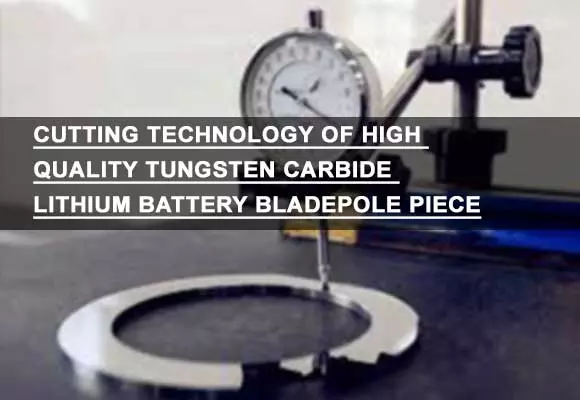
Cutting Technology of High Quality Tungsten Carbide Lithium Battery Blade Pole Piece

Production of pole pieces is the basic process for manufacturing lithium-ion power batteries, which requires very high equipment accuracy, intelligence level, and reliability of production performance. A Pole piece slitting machine is equipment for slitting rolled battery pole pieces according to battery specifications. The main technical requirement is that pole pieces after slitting must not appear wrinkled or de-powdering, and slitting size is required to have high precision. Burrs on the edge of the chip are small, otherwise, dendrites will pierce the diaphragm on the burrs and cause a short circuit inside the battery. Disc slitting knives mainly include upper and lower disc knives, which are installed on the cutter shaft of the slitting machine and use the rolling shear principle to slit aluminum foil, copper foil, and positive and negative pole pieces with a thickness of 0.01~0.1 mm. Here, we will sort out basic knowledge of the lithium battery pole piece disc slitting process.
Principles of pole piece disc slitting
Referring to the sheet metal disc slitting process, first introduce the basic principle of pole piece disc slitting. First, when the plate is in contact with the upper and lower blades, the plate will be elastically deformed by the pressure of the upper and lower blades, and due to the existence of the moment, the plate will bend, and shear stress will be generated in material near the gap. . With the rotation of blade point, plastic deformation occurs when internal stress state meets plastic conditions. As the shearing process continues, the shearing force on the plate becomes greater and greater, and it enters the shear yield state. The shear deformation zone begins to produce macroscopic slip deformation, and upper and lower round blades begin to cut into the material. At this time, the material of edge attachment produces plastic deformation, shear plastic slip is formed, and the section is bright. As the cutter head continues to rotate, the degree of plastic deformation of the material intensifies, the material will undergo work hardening, and its stress state will also change, resulting in microscopic cracks inside the material. As deformation continues, these micro-cracks merge into the main. Crack transforms into crack propagation and separation, and section forms a tear zone.

Compared with sheet metal slitting processing, the cutting method of lithium battery pole piece disc cutter has completely different characteristics:
(1) When cutting pole pieces, upper and lower disc knives have a back angle, which is similar to the blade of scissors, and the width of the blade is very small. There is no horizontal gap between upper and lower disc knives, but upper and lower knives are in contact with each other and there is lateral pressure.
(2) Basically, there are rubber rollers on the upper and lower sides of the sheet when slitting, which balances the shearing force and shearing moment generated by upper and lower knives during cutting and avoids substantial deformation of the sheet. The pole piece slitting has no upper and lower rollers.
(3) The pole piece coating is a composite material composed of particles, which has almost no plastic deformation ability. When internal stress generated by upper and lower disc cutters is greater than the bonding force between coating particles, the coating will crack and expand and separate.

The main failure mode of disc cutter
In the pole piece slitting process, the quality of the slitting disc blade directly affects pole piece slitting performance. The slitting machine needs to run for a long time, so it is necessary for the slitting blade to have good mechanical properties, such as hardness, manufacturing technology, and wear resistance. Disc cutter has a certain life span during continuous operation, and cutter life needs to be managed in the cutting process. Generally, the main failure mode of pole piece disc cutter is tool wear, which includes:
(1) Fatigue failure
Pole piece slitting disc cutter has lateral pressure. Upper and lower cutters overlap each other on side of the cutting edge. During the continuous slitting process, stress on the cutting edge is large and concentrated. Due to frequent extrusion, shearing, friction, and cyclic crossover, The effect of the variable mechanical load are prone to fatigue micro-cracks in the cutting edge area, and then under the action of cyclic stress, it will expand along the side of the disc cutter to center. When crack grows to a certain extent, stress reaches the strength limit of tool material It will cause local micro-breakage of the cutting edge of the tool.
(2) Adhesive wear
Adhesives with squeezing marks can also be found in the wear area of the tool. These adhesives are formed by sticking pole piece debris on the tool. This is because the side of the disc cutter is in contact with the pole piece cutting surface, and there is a large contact pressure, so that part of the cutting material is cold welded to the side of the disc cutter. These bonding layers continuously fall off during the cyclic slitting process and then re-form. The fall-off process may cause the hard phase of the tool to fall off, and aggravate the wear process. This situation is easiest to form when slitting aluminum foil. Due to the low melting point of aluminum, cutting chips and the side of the tool stick together to cause tool wear and shorten life.
(3) Abrasive wear
Although the hardness of cutting chips and pole pieces is lower than the hardness of the tool, they often contain some extremely high hardness tiny hardpoints, which can engrave grooves on the tool surface, which is abrasive wear.
Welcome to Konetool to buy a round cutting blade suitable for your lithium battery.